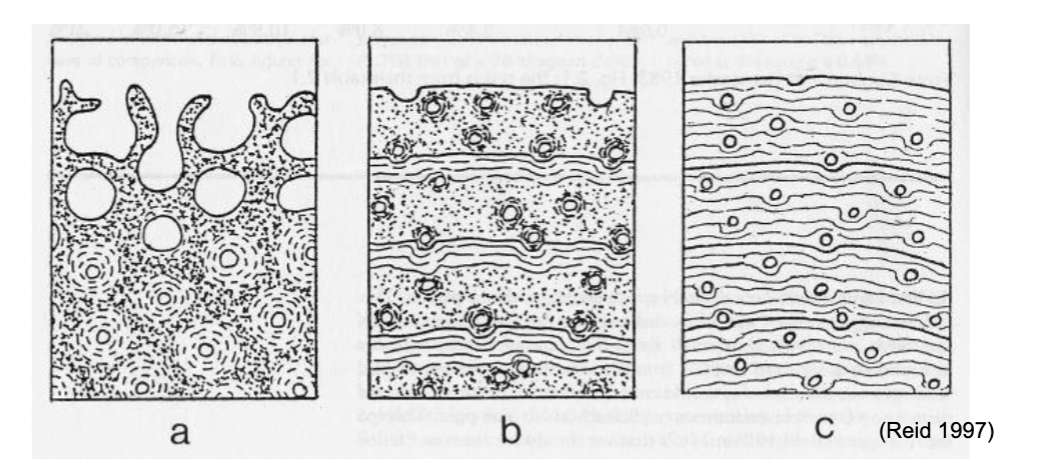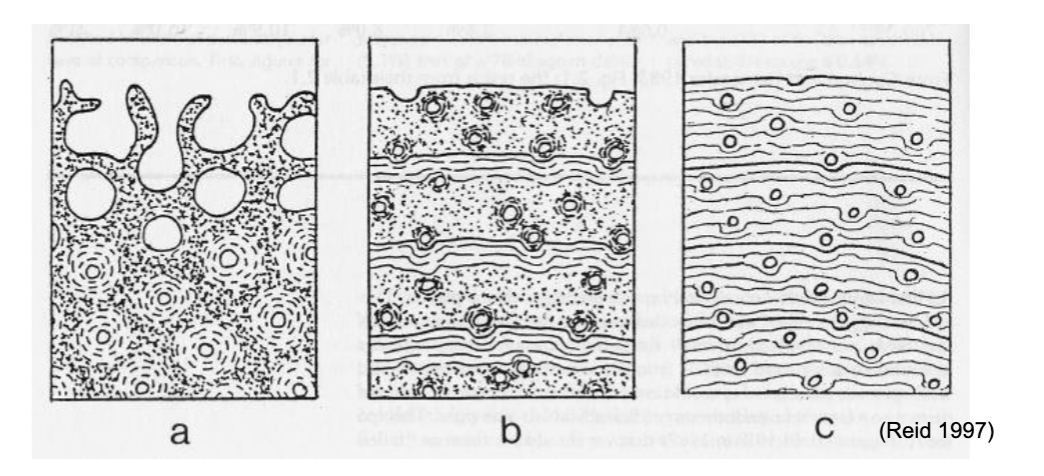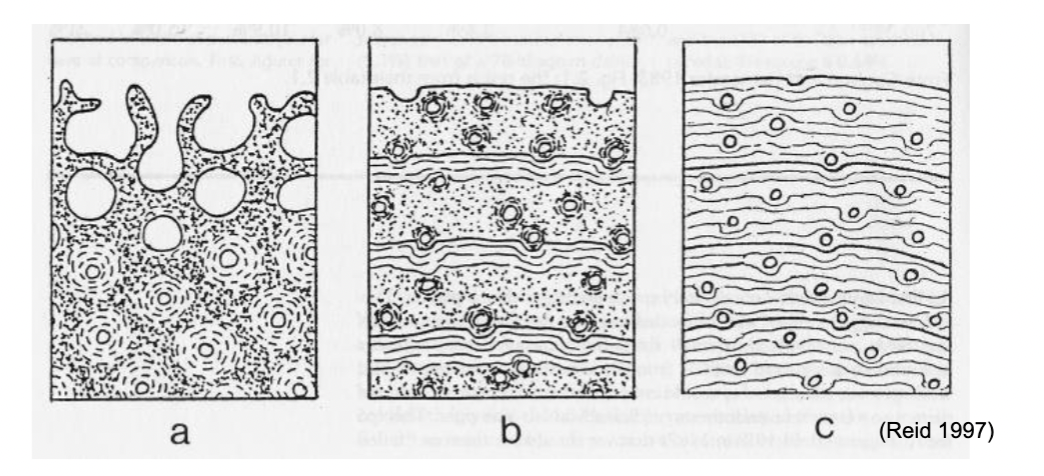module 8: histology growth 1
1/26
There's no tags or description
Looks like no tags are added yet.
Name | Mastery | Learn | Test | Matching | Spaced |
|---|
No study sessions yet.
27 Terms
not constant
in dinosaurs, growth was …, it occurred in seasonal cycles
cyclical growth marks
cycles left ____ ___ ___ (CGMs) in the bone
most common is lines of arrested growth (or LAGs)
since the cycles were yearly, counting the LAGs = a minimum estimate of the age of the dinosaur
ontogenetic age
growth rate & pattern
metabolism
what can bone microstructure tell us?
a
growing fibro-lamellar bone (FLB) showing formation of primary osteons (a, b, or c?)

b
zonal bone with fibro-lamellar zones, lamellar annuli, & lines of arrested growth (LAGs)

c
zonal bone with lamellar zones & LAGs

subadult Edmontosaurus femur
Alternating bands of reticular (faster growth) and circumferential (slower growth) FLB
No real LAGs, but clearly cyclical growth variation
Possibly recording periodic (seasonal?) nutritional stress?
More faster growing tissue in the earlier (younger) growth bands
primary osteons
result from appositional bone growth
secondary osteons
result from bone modeling
resorption & redeposition of bone tissue as part of mineral metabolism
can overprint/obscure original bon growth patterns
can identify through cross-cutting relationships
life history recorded on histology
Cross-section of humerus from adult turkey vulture (Cathartes aura)
M = medullary cavity
Scale bar = 78 μm
Fibrolamellar bone (FLB; fast-growing) from juvenile growth stage surrounded by periosteal (external) and endosteal (internal) lamellar bone indicating slowed growth and attainment of adult size

Suuwassea emiliae
originally considered a subadult on body size & bone fusion characters in vertebrae & skull
some characters that distinguish it from other Morrison Fm. sauropods are “primitive” characters that may also correlate w/ subadult status
sauropod bones are difficult to numerically age bc of high dgrees of secondary remodeling tend to obscure growth marks
histologists describes HOS that correlates with BOS and this allows relative aging of sauropods & identification of ontogenetic stages
HOS
histological ontogenetic stages
BOS
biological ontogenetic stages
even if u have CGMs/LAGs, they only give minimum individual age estimates
medullary expansion
bones don’t just get thicker thru ontogeny
earlier LAGs are resorbed & lost
smaller individuals can help reconstruct the early phases
why is the growth series of taxa critical to investigating dinosaur growth?
like modern mammals & birds, dinos appear to largely have has determinate growth
Maiasaura: approx. 7-8 years
Apatosaurus: approx. 15-20 years
Tyrannosaurus: approx. 22 years
how long does it take to reach mature size?
determinate growth
growth stops after a certain point (usually, shortly after reproductive age is reached)
age & growth rates
large dinos grew FAST
Maiasaura: 500 kg (1100 lbs)/yr
Tyrannosaurus: 840 kg (1825 lbs)/year
get these #s by comparing age & size ^
growth in dinosaurs followed typical “S”-shaped curve
growth starts slowly, accelerates rapidly through the major growth phase (pre-sexual maturity) then levels off after sexual maturity reached
what is the curve most dinosaurs follow in terms of age vs mass?
T. rex reached maturity by ~22 years old and growth leveled off after that
most T. rex specimen = young, averaging 18 years old
T. rex died at ~30 years old
other Tyrannosaurids lived to similar ages BUT on this scale their growth curves are depressed, reflecting smaller sizes
Describe the growth in Tyrannosaurids.
length
needs a full & complete skeleton, or the ability to extrapolate the effect of missing bones based on complete skeletons of closely related taxa
most growth curve reconstructions use mass
What do we mean by size?
we can’t directly
mass of animal > mass of its skeleton
so, volumetric models and/or linear regression used
How do we measure dinosaur mass?
volumetric model to estimate dinosaur mass
water displacement
create a physical model
measure volume of water the physical model displaces
multiply volume by an “average” body density for archosaurs to find mass
computer model
calculate fraction of body made up of various tissues & empty space
multiply by observed densities of tissues in modern animals
only works for very completely known animals
linear regression model to estimate dinosaur mass
how linear measurements in scale w/ body size in modern animals
femur circumference has tightest relationship
develop allometric equation for the relationship between the two
use linear measurements of dinosaur bone to calculate estimated body mass
can be used for fragmentary remains
extremely long growth period?
NO: histology doesn’t support this
parasagittal limb stance?
mammals also have this, and yes, some elephant & rhino relatives get very large, but nowhere near the largest of dinos
very efficient hearts & lungs?
well, YES, but crocodilians & modern birds have these too
short food chains?
less total energy loss w/ fewer “steps”
maybe part of it? largest mammals tend to be in short food chains
higher oxygen levels in mesozoic atmosphere?
some paleoclimate & geochemical models suggest higher oxygen levels than today
increase in primary productivity widens the base of the food energy pyramid, therefore you can have larger herbivores
Why did dinosaurs get so big?
Dreadnoughtus schrani
among largest known of titanosaurs
mass estimate 59.3 metric tons based on limb height & circumference
long bone histology
inner cortex densely remodeled
black arrow & green line indicate out extent of dense secondary osteon formation
outer cortex well-vascularized primary FLB
no visible LAGs or EFS